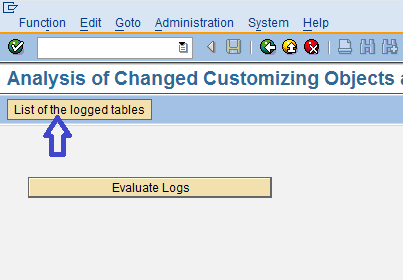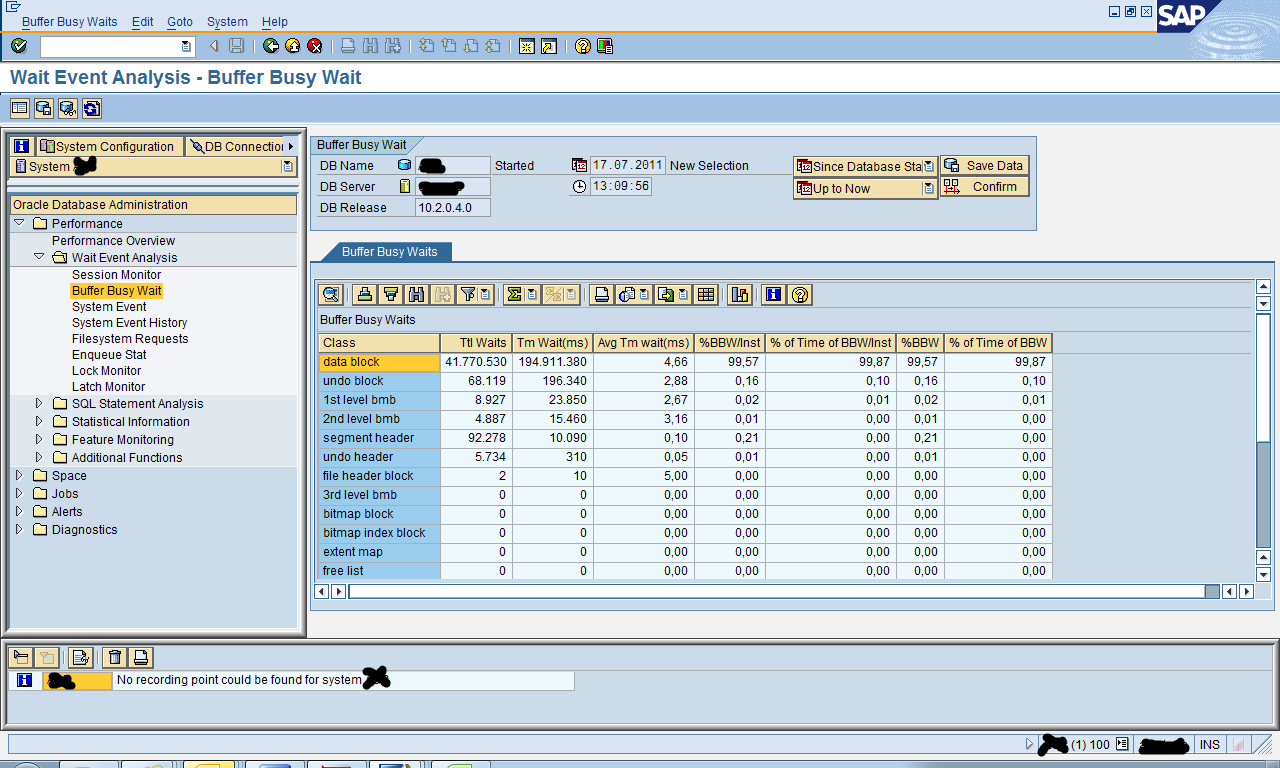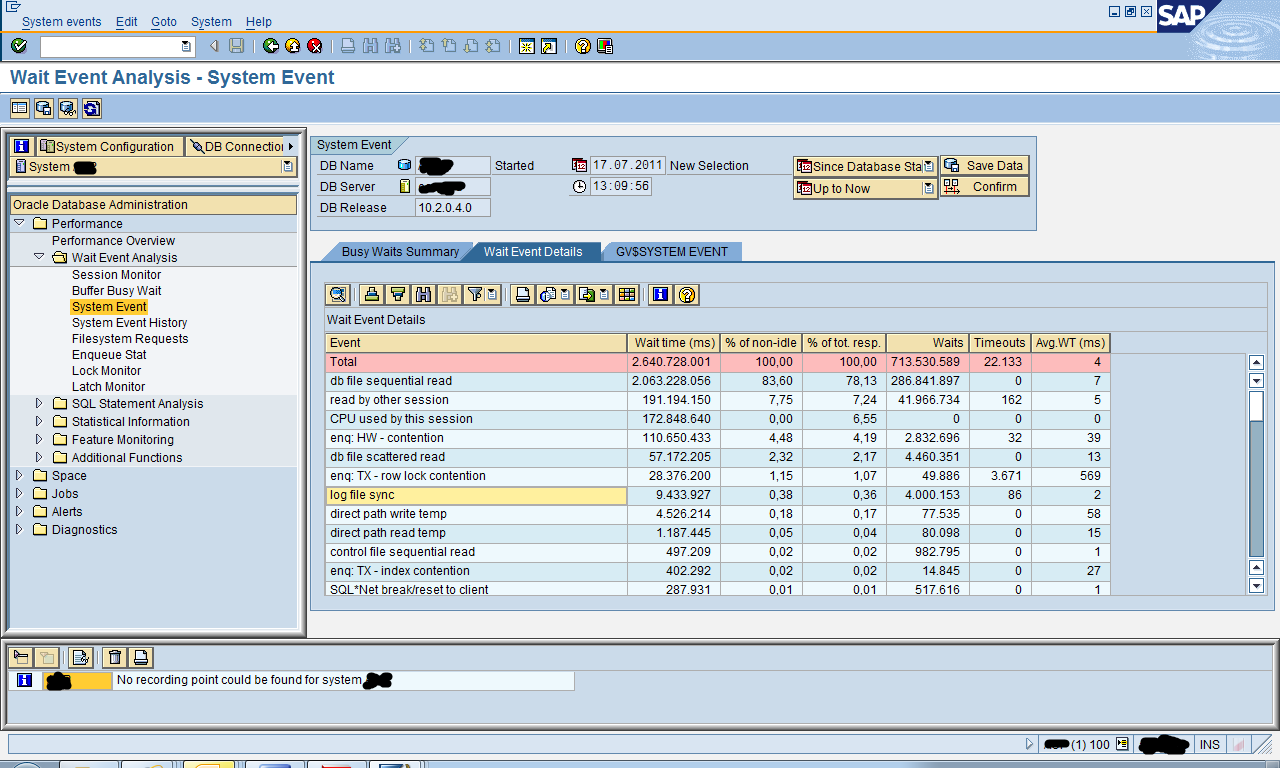Hi,
If you need access to SAP ECC 6 EHP 7 IDES please send me an email at rolando_rh@yahoo.com
All you need is SAP GUI installed and internet connection, you will be good to go.
Cheers

Hi,
If you need access to SAP ECC 6 EHP 7 IDES please send me an email at rolando_rh@yahoo.com
All you need is SAP GUI installed and internet connection, you will be good to go.
Cheers
Dear All,
Today I’m going to share my notes on SAP Table Logging.
Must be activated using profile parameter : rec/client {ALL, OFF, <client, client>}
List of Log table: SCU3

Table logs are stored in DBTABLOG table.
Evaluate table logging SCU3 (enter view name as in SM30)

SCDO: Change document object
I hope you find this note useful.
Hi All,
Today I’m going to share my notes on SAP integrated Internet Transaction Server (ITS).
http://<host>:<port>/sap/bc/gui/sap/its/webgui (OSS 698329)
SMICM –> Goto –> Trace File –> Display All
Transaction to monitor ITS : SITSPMON
sap/bc/gui/sap/its/test/mobile/itsmobile00
http://<ip address>:5<sys-num>13/sapmc/sapmc.html
I hope you find this note useful.
The portal is shipped with a standard set of logon screens. These include the screen in which users enter their user ID and password, the screen for requesting help from an administrator, and so on. If required, you can change these screens to reflect your company’s look and feel. To do this, you have to modify the Java Server Pages (JSPs) of the logon component shipped by SAP and reconfigure user management to use the modified logon component.
The standard logon component containing the code and resources used by the logon screens is shipped in a portal archive (PAR) file named com.sap.portal.runtime.logon.par.
If you want to change only the branding image displayed in the logon screen, you can configure this using the user management property ume.logon.branding_image
The changes you make to the logon screens can be overwritten during an upgrade. For this reason you should always make a copy of any file before changing it. After an upgrade you have to reconfigure your changes.
Make a Copy of the Standard Logon Component and Modify It
The modified logon screens are displayed at logon.
You can change the authschemes.xml file using the Config Tool of SAP Web Application Server Java. When you edit the file, you should download the file to a local directory, edit it, and when uploading the edited file, create a new node in the configuration tree for it. In this way you do not loose the original version of the file.
All dispatcher and server nodes in the cluster are shut down.
su – <sidadm>
export DISPLAY=<ip address>:0.0
cd /usr/sap/SM0/DVEBMGS02/j2ee/admin
./go
Visual Administrator by choosing Security Provider Service -> Runtime -> Login Sessions
sdm.bat jstartup “mode=integrated” (Integrated with sapstart / MMC)
sdm.bat jstartup “mode=standalone”
./sdm.sh shutdown sdmguiport=50018 shutdownmode=abort
Hi All,
Today I’m going to share my notes on enabling SAP ECC system data extraction. Below are the list of transaction related to the task.
I hope you find it useful.
Dear All,
This time, I’d like to share with you a list of SAP transaction codes used to enable and configure SAP Archiving to run.
I hope you find the list above useful.
Hi All,
Below are the list of SAP transaction codes used to configure ALE connection in SAP system. I hope you find this list useful.
Hi All,
This time, I’d like to share with you my notes on SAP-Oracle RDBMS performance based on SAP OSS Notes 618868 (FAQ: Oracle performance)
| 1 | Which prerequisites are required for a detailed performance analysis? |
| The Oracle parameter timed_statistics should be set to TRUE so that Oracle logs information on the time usage. This parameter can ALSO be activated dynamically using | |
| ALTER SYSTEM SET TIMED_STATISTICS = TRUE; | |
| 2 | How can I determine whether the database performance can be optimized? |
| ST03 : | database time column and should not exceed 40% of the overall response time. |
| ST04 : | Time/User call values of more than 15ms show room for improvement. |
| The ratio of Busy wait time to CPU time ratio of 60:40 generally indicates an optimized system. Significantly higher values (for example, 80:20) indicate potential for improvement. | |
| ST04 -> Detail Analysis Menu -> File System Requests”, check whether the average read cycle (“Avg(ms)” for “Blk Reads”) for individual data files or the total (Total under the column) seems too high (> > 10 ms). If so, check whether the problem can be solved by improved distribution of data | |
| Check the hit ratio (“Quality”) of the buffered data. This should be at least 94% for normal operation. | |
| – DD cache quality > 80 % – pinratio >= 95 – reloads/pin = 2 are fulfilled in normal operation. If not, the value set for the shared pool may be too low. |
|
| Detail Analysis Menu -> SQL Requests”, check which SQL statements are responsible for most buffer gets or disk reads and whether they can be optimized. A statement is considered buffer-intensive if it causes more than 5% of all buffer gets or more than 2% of all disk reads | |
| The “Reads/User call” value in ST04 is an index for buffer-intensive SQL statements. If this is above 20, the SQL statements should be checked in detail. | |
| ST06 : | Check whether sufficient CPU and memory resources are available on the database server. The IDLE time of the CPUs should be greater than or equal to 30% per hour on average. A maximum of 20% of RAM memory only should be swapped per hour. |
| DB02 : | Missing indexes, |
| ST10 : | (“all tables”/”since startup”/”this server”) |
| – Sort the list by the “Rows affected” column, which is a measure of the database load generated by accesses to the table. If buffered tables are (“Buffer state” column is not empty) very high, check their buffering. Large tables and tables with frequent | |
| – Sort the list by the “Invalidations” or “Changes” columns, and check whether tables with a high number of changes or invalidation should be removed from buffering. | |
| – Sort the list according to the “Buffer size” column and check whether buffering is advisable for tables with the largest buffer size. | |


I hope you find information useful.
Hi All,
Today I’m going to share my notes on SAP DBA tools for Oracle RDBMS.
| sapdba | ||
| initialization profile | /database/init.dba | |
| OS log file | /var/adm/messages | |
| Oracle messages | /oracle/PRD/saptrace/background/alertPRD.log | |
| /oracle/PRD/sapreorg | ||
| log files | .dba | Database startup and shutdown messages, deletion of logs, trace, and audit files, log of functions: restoring one tablespace (Restore/Recovery ® Restore one tablespace) or restoring individual files (Restore/Recovery ® Restore individual file(s)) |
| .rch | Log of the check function (in submenus of Reorganization ® Check extents and fragmentation) | |
| .ral | Log of function: configuration of storage parameters | |
| (Reorganization ® Alter/Show table or index storage parameters) | ||
| .rsi | Log of function: reorganize a single table or index | |
| (Reorganization ® Reorganize single table or index) | ||
| .rli | Log of function: Reorganize a list of objects (Reorganization ® Reorganize list of tables or indexes) | |
| .rtc | Log of function: Reorganization of a tablespace | |
| (Reorganization ® Reorganize tablespace) | ||
| .rtd | Log of function: reorganize a tablespace with data files | |
| (Reorganization ® Reorganize tablespace and datafiles) | ||
| .rmv | Log of function: change the data file assignment of a tablespace (Reorganization ® Move/rename data files of a tablespace) | |
| .rrs | Log of function: Resize data file (Reorganization ® Resize data files of a tablespace) | |
| .ext | Log of function: tablespace administration, including the data file statistics before and after the extension, and the messages displayed by the command ALTER TABLESPACE or CREATE TABLESPACE (Tablespace administration) | |
| .exd | Log of function: export with data (Export/import ® Export tables and indexes including data) | |
| .exs | Log of function: export tables and index structures | |
| (Export/import ® Export structures of tables and indexes) | ||
| .exg | Log of function: export other objects | |
| (Export/import ® Export constraints, synonyms, sequences, views, grants) | ||
| .imd | Log of function: import with data (Export/import ® Import tables and indexes including data) | |
| .ims | Log of function: structure import (Export/import ® Import structures) | |
| .chk | Statistics generated by using the SAPDBA command option | |
| -check (e.g. display using SAPDBA daily check log files) | ||
| .nxt | Log generated by using the SAPDBA command option | |
| -next (e.g. display using SAPDBA daily check log files) | ||
| .aly | Log generated by using the SAPDBA command option | |
| -analyze (e.g. display using SAPDBA daily check log files) | ||
| .opt | Log generated by using the SAPDBA command option | |
| -checkopt (requirements planning for the DB optimizer). | ||
| .brb | Log of the BRBACKUP call by SAPDBA (Backup database) | |
| .bra | Log of the BRARCHIVE call by SAPDBA (Backup archive log) | |
| .rcv | Log of function: recovery (Check (and repair) Database) | |
| .rsn | Log of function: recovery to current time (now) (Restore/Recovery ® Full restore and recovery) | |
| .rsp | Log of function: point in time recovery (Restore/Recovery ® Full restore and recovery) | |
| .rst | Log of function: restore the database (Restore/Recovery ® Full restore) | |
| esc.log | BRTOOLS logs (n=1,…,number of processes). Unlike the export, import logs, these are not appended to the main log . but are generated separately in the subdirectory of the working directory. | |
| esc_.log | ||
| exp|imp_.log | Depending on the number of parallel processes, from the second Oracle Export/Import process onwards (n=2,…,number of processes) partial, temporary logs are written. See Logs for Parallel Export and Import Processes. | |
| reorg.log | Central log with overview information on the operations performed. See Central Log reorg.log. | |
| struct.log | Structure log containing information on the structure of the database. See Structure Log. | |
| command parameters | sapdba -check | brconnect -f check |
| sapdba -next | brconnect -f next | |
| sapdba -checkopt|-analyze | brconnect -f stats | |
| sapdba -statistics | brconnect -f stats -p | |
| sapdba -delete | brconnect -f stats -d | |
| sapdba -cleanup | brconnect -f cleanup | |
| sapdba -sapr3|-alter_user | brconnect -f chpass | |
| sapdba -shutdown | brconnect -f dbshut | |
| sapdba -startup | brconnect -f dbstart | |
| sapdba -check_db_open | brconnect -f dbstate | |
| * Check database system: | brconnect -u / -c -f check | |
| * Adapt next extents: | brconnect -u / -c -f next -t all | |
| * Update optimizer statistics: | brconnect -u / -c -f stats -t all | |
| * Cleanup DBA logs: | brconnect -u / -c -f cleanup | |
| brspace –f dbalter –a noarchlog | ||
| brconnect -u / -c -f stats -t all -f collect | ||
| brconnect -V | check brtools version | |
| brspace -f dbparam | change Oracle init.ora and Server parameter file (SPFILE) | |
| brrestore -V | check version | |
| brrestore -h | help on options | |
| brbackup -V | check version | |
| brbackup -h | help on options | |
| brrestore -n | restore based on tape locations (control files, backup detailed log, etc) | |
| http://help.sap.com/saphelp_46c/helpdata/en/42/51b3144a1211d182b80000e829fbfe/frameset.htm | ||
| brrestore –n all_log | restore all backup log files | |
| brrestore –b beczqlnk.ant –m full | restore full backup | |
| brrestore –a 2224-2228=/oracle/BWP/oraarch/ | restore archive log | |
I hope you find this note useful.
Hi All,
Today I’m going to share my notes to copy table content across SAP client as described in SAP Notes 1942.
As an example, say we need to copy COEP table from client 100 to 300:
1. Create control file to export table: example: expcoep.ctrl
export
file = ‘expcoep.dat’
client = 100
select * from COEP where mandt=’100′
2. Execute R3trans to export table to OS level file:
R3trans -w expcoep.log -u 18 expcoep.ctrl &
3. Create control file to import table contents: example: impcoep.ctrl
import
file = ‘expcoep.dat’
client = 300
4. Execute R3trans to import table from OS level file:
R3trans -w impcoep.log -u 18 impcoep.ctrl &
I hope this note is useful for you.